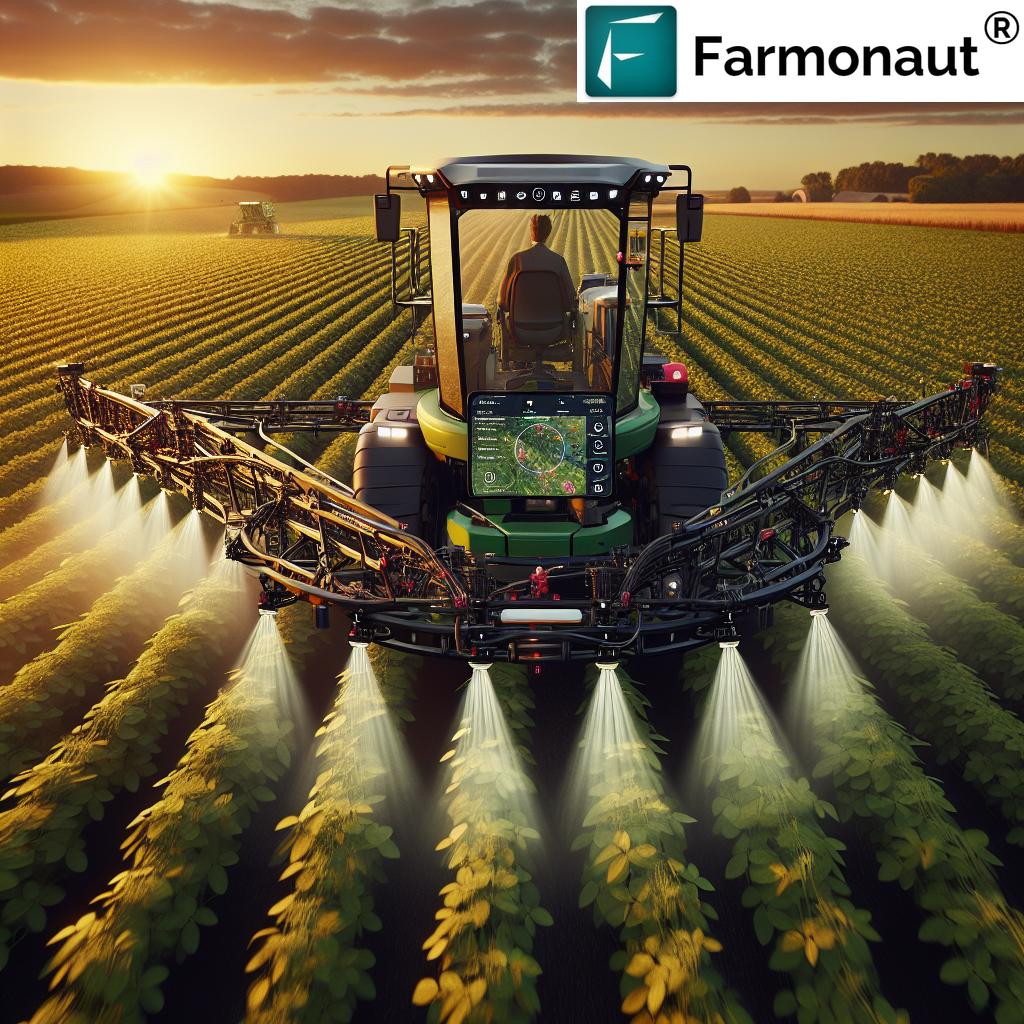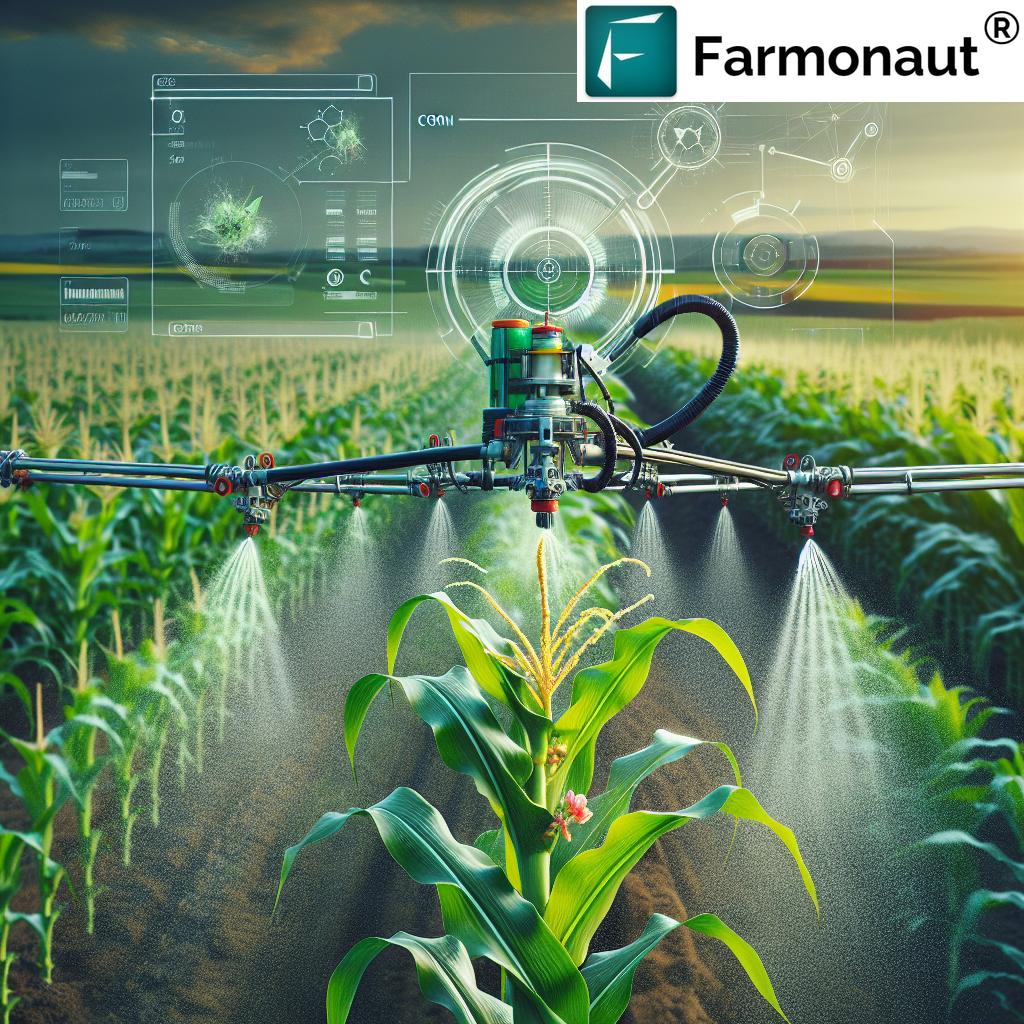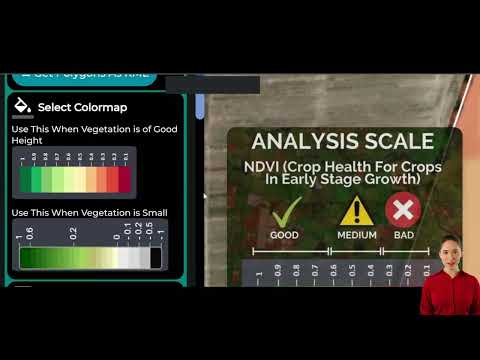Revolutionizing Precision Agriculture: How AI-Powered Spot Spraying Technology is Transforming Weed Management and Sustainability
“AI-powered spot spraying technology can reduce herbicide usage by up to 90% compared to traditional blanket spraying methods.”
In the ever-evolving landscape of modern agriculture, we are witnessing a revolutionary transformation in weed management and sustainability through the advent of AI-powered spot spraying technology. This cutting-edge innovation is reshaping the way we approach precision agriculture, offering unprecedented levels of efficiency and environmental stewardship. As we delve into this game-changing technology, we’ll explore how it’s not just changing farming practices but potentially redefining the future of agriculture itself.
The Dawn of AI in Crop Spraying
The integration of artificial intelligence (AI) in crop spraying represents a quantum leap in precision agriculture technology. Traditional methods of weed control often involved blanket spraying entire fields, leading to excessive chemical use and potential environmental harm. However, with the introduction of smart weed management systems, we’re seeing a paradigm shift in how we approach this crucial aspect of farming.
AI-powered spot spraying for agriculture leverages advanced computer vision and machine learning algorithms to identify and target individual weeds with remarkable accuracy. This level of precision was once thought impossible on a large scale, but today, it’s becoming increasingly accessible to farmers around the world.

The Technology Behind Smart Weed Management
At the heart of this revolution are sophisticated sprayers equipped with high-resolution cameras, powerful onboard computers, and precision nozzles. As these sprayers move across the field, they continuously scan the ground, using AI algorithms to distinguish between crops and weeds in real-time. When a weed is detected, the system triggers a targeted spray, applying herbicide only where it’s needed.
This level of precision is made possible by several key technological advancements:
- Advanced Image Recognition: AI algorithms can identify different plant species with incredible accuracy, even at high speeds.
- Real-time Processing: Onboard computers make split-second decisions, allowing for immediate action as weeds are detected.
- Precision Application: High-tech nozzles can deliver precise amounts of herbicide, minimizing drift and overspray.
- GPS Integration: Many systems incorporate GPS technology for mapping and tracking treated areas.
The Benefits of AI-Powered Spot Spraying
The advantages of this technology are numerous and far-reaching:
- Reduced Chemical Usage: By targeting only weeds, farmers can dramatically reduce the amount of herbicide used, often by 50-90%.
- Cost Savings: Less chemical use translates to lower input costs for farmers.
- Environmental Protection: Minimized chemical application means less runoff and reduced impact on soil and water systems.
- Improved Crop Health: Targeted spraying reduces the risk of crop damage from herbicide exposure.
- Data-Driven Insights: These systems often collect valuable data on weed populations and distribution, informing future management decisions.
“Advanced sprayer systems with carbon fibre booms can cover up to 120 feet in a single pass, increasing efficiency in large-scale farming operations.”
Sustainable Herbicide Application: A New Era
The shift towards sustainable herbicide application is not just a technological advancement; it’s a response to growing environmental concerns and the need for more responsible farming practices. AI-powered spot spraying aligns perfectly with these goals, offering a way to maintain crop yields while significantly reducing the environmental footprint of weed control.
This approach to sustainable herbicide application is particularly crucial in light of increasing regulations on chemical use in agriculture. By adopting these smart systems, farmers can stay ahead of regulatory changes while also appealing to consumers who are increasingly concerned about the environmental impact of their food production.
The Role of Precision Farming Equipment
The effectiveness of AI-powered spot spraying is heavily dependent on the quality and capabilities of the precision farming equipment used. Modern sprayers are marvels of engineering, featuring:
- Carbon Fibre Booms: Lightweight yet incredibly strong, these booms allow for wider coverage and more stable spraying, even at higher speeds.
- Self-Propelled Sprayers: These machines offer greater maneuverability and efficiency, especially in larger fields.
- Advanced Nozzle Technology: Precision nozzles can adjust droplet size and spray pattern based on wind conditions and target type.
- Integrated Sensors: Various sensors monitor factors like boom height, ground speed, and weather conditions to optimize spray application.
The integration of these advanced features in modern sprayers is essential for maximizing the benefits of AI-powered spot spraying technology.
Comparative Analysis: Traditional vs. AI-Powered Spot Spraying
| Aspect | Traditional Spraying | AI-Powered Spot Spraying |
|---|---|---|
| Chemical Usage | 100% application across field | Estimated 50-90% reduction |
| Accuracy | Low – blanket coverage | High – precise targeting of weeds |
| Cost-Effectiveness | High chemical costs | Reduced chemical costs, higher initial equipment investment |
| Environmental Impact | Higher risk of chemical runoff and soil contamination | Significantly reduced environmental impact |
| Integration with Other Technologies | Limited | High – integrates with GPS, weather data, and farm management systems |
Applications Across Different Crops
While the benefits of AI-powered spot spraying are clear, it’s important to note that its applications extend beyond just corn and soybean fields. This technology is proving valuable across a wide range of crops:
- Small Grains: In wheat, barley, and oat fields, spot spraying can effectively target weeds without damaging the crop.
- Cotton: Precision application is crucial in cotton fields to manage weeds without affecting the delicate cotton plants.
- Vegetables: For high-value vegetable crops, reducing chemical exposure is particularly important, making spot spraying an ideal solution.
- Orchards and Vineyards: Even in permanent crop settings, AI-powered sprayers can target weeds growing between rows or trees.
This versatility makes AI-powered spot spraying a valuable tool across diverse agricultural landscapes.

Integration with Crop Health Monitoring Technology
The true power of AI-powered spot spraying is fully realized when integrated with broader crop health monitoring systems. This is where digital agriculture solutions like those offered by Farmonaut come into play. By combining satellite imagery, weather data, and on-the-ground sensors, farmers can create a comprehensive picture of their field’s health and weed pressure.
This integration allows for:
- Predictive Weed Management: By analyzing historical data and current field conditions, AI can predict where weed problems are likely to occur.
- Optimized Spraying Schedules: Integrating weather forecasts ensures that spraying is done under ideal conditions for maximum effectiveness.
- Precision Resource Allocation: Farmers can allocate resources more efficiently by focusing on areas with the highest weed pressure.
For more information on how satellite technology is revolutionizing land use in agriculture, check out Farmonaut’s comprehensive solutions:
The Future of AI in Agriculture
As we look to the future, the potential for AI in agriculture extends far beyond weed management. We’re seeing developments in:
- Autonomous Farm Equipment: Self-driving tractors and harvesters that can operate 24/7.
- Predictive Yield Models: AI algorithms that can predict crop yields with incredible accuracy months in advance.
- Pest and Disease Detection: Similar to weed detection, AI is being used to identify and treat pest infestations and diseases early.
- Precision Planting and Harvesting: AI-guided systems that optimize seed placement and harvesting techniques.
These advancements are not just improving efficiency; they’re fundamentally changing how we approach farming, making it more precise, sustainable, and productive.
Challenges and Considerations
While the benefits of AI-powered spot spraying are significant, it’s important to acknowledge the challenges and considerations:
- Initial Investment: The upfront cost of advanced spraying equipment can be substantial.
- Training and Adoption: Farmers and operators need training to effectively use and maintain these sophisticated systems.
- Data Management: Handling and interpreting the large amounts of data generated by these systems can be challenging.
- Reliability in Diverse Conditions: Ensuring consistent performance across various weather conditions and crop types is ongoing work.
Addressing these challenges is crucial for the widespread adoption of this technology.
The Role of Weather Data in Precision Spraying
Weather conditions play a critical role in the effectiveness of herbicide application. AI-powered spot spraying systems often incorporate real-time weather data to optimize spraying operations. This integration allows for:
- Wind Speed and Direction Monitoring: Adjusting spray patterns to minimize drift in windy conditions.
- Temperature and Humidity Tracking: Ensuring herbicides are applied under optimal conditions for absorption.
- Rainfall Prediction: Avoiding application before expected rainfall to prevent runoff.
By considering these factors, farmers can significantly improve the efficacy of their weed control efforts while minimizing environmental impact.
For detailed weather data and its application in agriculture, explore Farmonaut’s API:
For developers looking to integrate this technology into their own systems, check out the API documentation:
Economic Impact on Farming Operations
The adoption of AI-powered spot spraying technology can have a significant economic impact on farming operations:
- Reduced Input Costs: The substantial reduction in herbicide use translates to lower chemical costs.
- Improved Yield Potential: More precise weed control can lead to better crop growth and potentially higher yields.
- Labor Efficiency: Automated systems can reduce the labor required for weed management.
- Long-term Soil Health: Reduced chemical use can improve soil health over time, potentially leading to better crop performance in future seasons.
While the initial investment in this technology can be significant, many farmers find that the long-term benefits outweigh the costs.
The Global Impact of Precision Agriculture
The implications of AI-powered spot spraying extend far beyond individual farms. On a global scale, this technology has the potential to:
- Reduce Environmental Impact: Minimizing chemical use in agriculture can have far-reaching positive effects on ecosystems and biodiversity.
- Enhance Food Security: More efficient farming practices can lead to increased crop yields and more stable food production.
- Address Labor Shortages: As many regions face agricultural labor shortages, automation can help fill the gap.
- Promote Sustainable Farming: This technology aligns with global efforts to make agriculture more sustainable and environmentally friendly.
The Role of Mobile Technology in Modern Farming
Mobile technology plays a crucial role in making AI-powered farming solutions accessible to farmers. With smartphone apps, farmers can access real-time data, control equipment, and make informed decisions from anywhere. Farmonaut offers both Android and iOS apps to support farmers in this digital transition:
Frequently Asked Questions
- Q: How accurate are AI-powered spot spraying systems?
A: Modern systems can achieve accuracy rates of up to 95% in identifying and targeting weeds, depending on conditions and crop type. - Q: Can these systems work at night?
A: Yes, many advanced systems use infrared cameras and lighting, allowing for 24/7 operation. - Q: How does weather affect the effectiveness of spot spraying?
A: Weather conditions like wind, temperature, and humidity can significantly impact spraying effectiveness. Many AI systems incorporate real-time weather data to optimize application. - Q: Is AI-powered spot spraying suitable for small farms?
A: While initially developed for large-scale operations, there are increasingly affordable options becoming available for smaller farms. - Q: How does this technology integrate with existing farm equipment?
A: Many systems can be retrofitted to existing sprayers, while others come as part of new, fully integrated spraying equipment.
Conclusion: The Future of Farming is Here
AI-powered spot spraying technology represents a significant leap forward in precision agriculture. By dramatically reducing chemical usage, improving efficiency, and promoting sustainability, this technology is not just changing how we manage weeds—it’s transforming the entire landscape of modern farming.
As we look to the future, the integration of AI, satellite imagery, and advanced machinery promises to make agriculture more precise, sustainable, and productive than ever before. While challenges remain, the potential benefits for farmers, consumers, and the environment are immense.
For those looking to stay at the forefront of these technological advancements, Farmonaut offers comprehensive digital agriculture solutions. From satellite-based crop monitoring to AI-driven insights, Farmonaut is committed to making precision agriculture accessible to farmers worldwide.
Embrace the future of farming with Farmonaut’s cutting-edge solutions:
As we continue to innovate and refine these technologies, the dream of a more sustainable and productive agricultural future is becoming a reality. The revolution in precision agriculture is here, and it’s powered by AI, data, and the ingenuity of farmers and technologists working together to feed the world more efficiently and sustainably than ever before.






